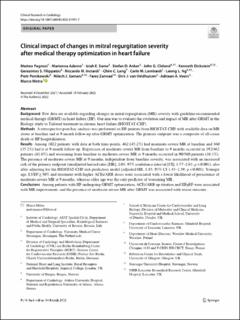| dc.contributor.author | Pagnesi, Matteo | |
| dc.contributor.author | Adamo, Marianna | |
| dc.contributor.author | Sama, Iziah E. | |
| dc.contributor.author | Anker, Stefan D. | |
| dc.contributor.author | Cleland, John G. | |
| dc.contributor.author | Dickstein, Kenneth | |
| dc.contributor.author | Filippatos, Gerasimos S. | |
| dc.contributor.author | Inciardi, Riccardo M. | |
| dc.contributor.author | Lang, Chim C. | |
| dc.contributor.author | Lombardi, Carlo | |
| dc.contributor.author | Ng, Leong L. | |
| dc.contributor.author | Ponikowski, Piotr | |
| dc.contributor.author | Samani, Nilesh J. | |
| dc.contributor.author | Zannad, Faiez | |
| dc.contributor.author | van Veldhuisen, Dirk J. | |
| dc.contributor.author | Voors, Adriaan A. | |
| dc.contributor.author | Metra, Marco | |
| dc.date.accessioned | 2022-05-27T12:37:41Z | |
| dc.date.available | 2022-05-27T12:37:41Z | |
| dc.date.created | 2022-04-03T19:28:33Z | |
| dc.date.issued | 2022 | |
| dc.identifier.issn | 1861-0684 | |
| dc.identifier.uri | https://hdl.handle.net/11250/2996492 | |
| dc.description.abstract | Background: Few data are available regarding changes in mitral regurgitation (MR) severity with guideline-recommended medical therapy (GRMT) in heart failure (HF). Our aim was to evaluate the evolution and impact of MR after GRMT in the Biology study to Tailored treatment in chronic heart failure (BIOSTAT-CHF).
Methods: A retrospective post-hoc analysis was performed on HF patients from BIOSTAT-CHF with available data on MR status at baseline and at 9-month follow-up after GRMT optimization. The primary endpoint was a composite of all-cause death or HF hospitalization.
Results: Among 1022 patients with data at both time-points, 462 (45.2%) had moderate-severe MR at baseline and 360 (35.2%) had it at 9-month follow-up. Regression of moderate-severe MR from baseline to 9 months occurred in 192/462 patients (41.6%) and worsening from baseline to moderate-severe MR at 9 months occurred in 90/560 patients (16.1%). The presence of moderate-severe MR at 9 months, independent from baseline severity, was associated with an increased risk of the primary endpoint (unadjusted hazard ratio [HR], 2.03; 95% confidence interval [CI], 1.57–2.63; p < 0.001), also after adjusting for the BIOSTAT-CHF risk-prediction model (adjusted HR, 1.85; 95% CI 1.43–2.39; p < 0.001). Younger age, LVEF ≥ 50% and treatment with higher ACEi/ARB doses were associated with a lower likelihood of persistence of moderate-severe MR at 9 months, whereas older age was the only predictor of worsening MR.
Conclusions: Among patients with HF undergoing GRMT optimization, ACEi/ARB up-titration and HFpEF were associated with MR improvement, and the presence of moderate-severe MR after GRMT was associated with worse outcome. | en_US |
| dc.language.iso | eng | en_US |
| dc.publisher | Springer | en_US |
| dc.rights | Navngivelse 4.0 Internasjonal | * |
| dc.rights.uri | http://creativecommons.org/licenses/by/4.0/deed.no | * |
| dc.title | Clinical impact of changes in mitral regurgitation severity after medical therapy optimization in heart failure | en_US |
| dc.type | Journal article | en_US |
| dc.type | Peer reviewed | en_US |
| dc.description.version | publishedVersion | en_US |
| dc.rights.holder | Copyright 2022 the authors | en_US |
| cristin.ispublished | true | |
| cristin.fulltext | original | |
| cristin.qualitycode | 1 | |
| dc.identifier.doi | 10.1007/s00392-022-01991-7 | |
| dc.identifier.cristin | 2014923 | |
| dc.source.journal | Clinical Research in Cardiology | en_US |
| dc.identifier.citation | Clinical Research in Cardiology. 2022. | en_US |

